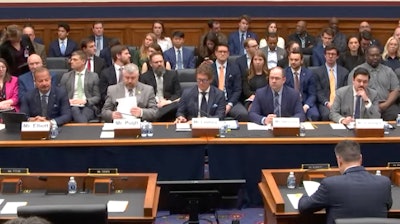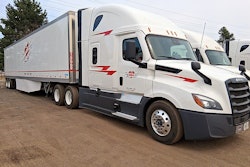
The Highways and Transit Subcommittee on Wednesday reviewed U.S. Department of Transportation policies and programs affecting the trucking industry.
Four industry stakeholders were called as witnesses to provide testimony before the committee, charged with laying out the industry's top challenges and potential solutions as Congress prepares to reauthorize surface transportation programs.
Owner-Operator Independent Drivers Association (OOIDA) Executive Vice President Lewie Pugh noted at the hearing that this Congressional term has "the opportunity to pass the most pro-trucker highway bill in history."
Taking center stage was concern for the Highway Trust Fund (HTF), which has a projected deficit of more than $270 billion from 2025 to 2034, according to the Tax Foundation.
John Elliott, executive chairman of Michigan-based expeditor Load One (CCJ Top 250, No. 159) and past chairman of the Truckload Carriers Association, said his organization supports increasing fuel taxes to shore up the HTF provided they are indexed to an appropriate annual cap as needed with all generated funds dedicated to critical highway infrastructure projects.
As trucks get better fuel economy, the amount of highway funding goes down, a problem that is multiplied by electric vehicles that don't pay fuel taxes at all but continue to use the roads.
"The fuel tax system is a good system," Elliott said. "It’s time to update it."
The tax currently stands at 18.4 cents per gallon for gasoline and 24.4 cents per gallon for diesel, which has been unchanged since 1993. Administrative costs associated with collecting these taxes account for just 1% of every dollar paid. However, Elliott said, the HTF continues to face persistent shortfalls "because the federal government has not taken the necessary steps to ensure sustainable, long-term funding for our critical infrastructure."
OOIDA has long advocated for increases to existing fuel taxes, Pugh said, as a way to pay for increased infrastructure spending.
"If Congress is considering raising revenue, it should have the political courage to do this through proven, cost-effective methods like fuel taxes instead of methods like tolling that may limit political consequences but disproportionately harm truckers," he said, adding that the authorization of programs to administer Vehicle Miles Traveled (VMT) fees would be premature for the next highway bill.
The Infrastructure Investment & Jobs Act required the USDOT to create the Federal System Funding Alternative Advisory Board, a panel directed to analyze VMT. OOIDA has a seat on the advisory panel, but the board has yet to convene.
An area where motor carriers need some tax relief, Elliott said, is with the repeal of the 12% Federal Excise Tax (FET) on new heavy-duty trucks and trailers – a tax that adds an average of $22,000 to the cost of each vehicle.
"The high cost of the FET slows fleet modernization, directly impacting safety and environmental goals," he said, adding 60% of fleets report they would be somewhat or very likely to purchase more trucks if the FET were eliminated.
A measure to repeal FET has been introduced multiple times over the past several years but has not passed.
Speed limiters, automatic braking and side underride
The Federal Motor Carrier Safety Administration (FMCSA) revived its speed limiter debate in 2022 with a notice of intent to proceed with a rulemaking that would require the use of speed limiters on heavy trucks. The agency has delayed publication of proposed rulemaking at least twice, and it is currently slated potentially for next month with already strong support on the subcommittee.
Rep. Eleanor Holmes Norton (D-DC) advocated Wednesday getting speed limiters and automatic braking “onto trucks as quickly as possible."
While the maximum speed for a federal mandate has not been published or decided (Congress has delegated the authority to set limits to the states), Pugh said "this mandate would have a negative effect on road safety, crash rates, driver retention and supply chain performance, which is precisely why it is incredibly unpopular among professional drivers."
Conversely, the American Trucking Associations and Truckload Carriers Association have supported the implementation of both automatic emergency braking systems and speed limiters.
“I would not buy a new truck without AEB,” Elliott told the committee Wednesday. "AEB, coupled with Electronic Stability Control (ESC), is estimated to prevent 19,118 crashes, save 155 lives and reduce 8,814 nonfatal injuries. Not only will installing AEBs and ESCs save lives, but they estimate that these devices eliminate 24,828 property damage-only vehicle accidents."
OOIDA and TCA were united in their opposition to a potential side underride guard mandate, with Elliott sharing his disappointment that bills mandating side underride guards for all commercial vehicles have been introduced in both the House and the Senate "that seemingly disregard the fact that we are here to prevent accidents from happening, not justify them."
The National Highway Traffic Safety Administration (NHTSA) has considered numerous options involving side underride guards for decades, Pugh pointed out, but has consistently concluded federal mandates would be impractical and cost-prohibitive, and the Biden administration determined a side underride guard mandate could be the costliest mandate ever for the trucking industry – costs, Pugh said, outweigh the benefits nearly 10 to one.
HOS and ELDs
OOIDA in 2020 supported reforms that alleviated hours of service (HOS) rigidity, including modifications to the 30-minute rest break requirement and split-sleeper berth times, as well as expanded windows to avoid adverse driving conditions, and while these changes have proven helpful, Pugh said, "they do not fully solve all the safety and efficiency challenges associated with current HOS rules."
OOIDA has advocated for giving drivers the option to pause their 14-hour on-duty period with one off- duty period of no less than 30 minutes and no more than three hours – a “Split-Duty Period” that Pugh said provides truckers greater flexibility to rest when they’re tired and does not increase maximum driving time, maximum on-duty time or decrease minimum off-duty rest periods between shifts.
FMCSA in late 2020 proposed a Split Duty Period Pilot Program to evaluate whether this option would optimize productivity while maintaining safety, but the agency has not advanced the proposal since the public comment period closed in November 2020.
OOIDA also supports further expanding split sleeper-berth standards to include 6/4 and 5/5 splits. In January 2021, FMCSA drafted a Split Sleeper Pilot Program to examine 6/4 and 5/5 splits, but the proposal was never published in the Federal Register. Pugh told the committee that if FMCSA does not reopen these pilot programs, the committee should compel the agency to do so.
Drivers for the last eight years have been held accountable for their workday by electronic devices (ELD) that are certified by the companies that manufacture them. Over the years, more than 300 ELDs have had their compliance revoked by FMCSA, leaving drivers with devices they cannot use and little confidence that any device will be compliant long term.
Pugh challenged the committee to require FMCSA to implement a certification process that prevents non-compliant devices from entering the market in the first place and demanded Congress impose a ban on technology "from hostile nations like Russia and China from being utilized in ELDs that track American truckers."
"ELDs generate copious amounts of supply chain data, including the movement of specific vehicles," he said. "Allowing our enemies and competitors unimpeded access to this data should concern lawmakers as much as it does the truckers who are forced to use the devices. This kind of ban could also be achieved by enacting a rigorous certification process at FMCSA."
Drug testing
An increasing number of states have relaxed laws on marijuana use, yet it remains illegal at the federal level and a positive test remains an automatic disqualifier for holders of a commercial license, regardless which state they live in or are traveling through.
TCA, Elliott said, continues to support the idea that hair follicle testing should become a federally recognized alternative to urine-based drug testing nationwide and "allowing the results of hair follicle testing to be incorporated into the Drug and Alcohol Clearinghouse should become mandatory."
Currently only urine samples are recognized by DOT, but work is underway to include oral fluid/spit swab testing. The use of hair folicle testing has been debated for more than a decade but marjuana use among drivers will be a “bigger and bigger problem,” Elliott said, as more states legalize its use.
"We lack comparable technology to a breathalyzer,” Elliott added. "Trucking has a bigger problem than it realizes until that technology exists."
Pugh said OOIDA remains opposed to any sort of hair testing mandate that would be initiated by Congress or Health and Human Services over concerns that hair testing can lead to false positives due to contamination from the environment and the interference of cosmetic treatment on the analysis of hair. Variances in hair types have also posed difficulties in standardizing drug testing, he said, as has hair shape, size, color, texture, formation and other qualities that vary by race, sex, age and position on the scalp.
Elliott added that TCA also opposes the effort to reschedule marijuana from a Schedule I to a Schedule III drug.
Truck parking and bathroom access
A bipartisan group of lawmakers in February reintroduced legislation that would address the shortage of truck parking across the U.S. – long a top concern among drivers and fleets. Pugh said OOIDA would not support any surface transportation reauthorization that fails to dedicate federal funding for parking expansion.
The current highway bill, enacted as part of IIJA, increased spending on things "like commercial motor vehicle law enforcement, created new uses of funds from the Highway Trust Fund (HTF) for water infrastructure projects, vegetation management and other non-road projects, and authorized $800 million for a new bike lane program, as well as a new program to promote 'pollinator management' along highways," Pugh said.
"At the same time, Congress – specifically the Senate – failed to prioritize or dedicate funding for truck parking ... If the next surface transportation reauthorization fails to provide dedicated funding for truck parking but authorizes even a single penny of funding for new initiatives, OOIDA will use every tool it has to ensure the legislation is defeated."
Elliott added that the DOT's 2019 Jason's Law Report found that 98% of drivers struggle to find parking, "and the shortage exists in every state and region." Elliott and Pugh each listed truck parking as one of the primary barriers to entry for the industry – specifically for women – and one of the top problems industrywide.
As difficult as finding parking can be, finding a place to use the restroom can be an even more daunting task for drivers, even at shipper and receiver facilities – a problem that has gotten worse post-pandemic, Pugh said. He championed 2023's Trucker Bathroom Access Act as "straightforward, bipartisan legislation that would provide truckers the dignity and respect they deserve."
The bill, supported by trucking and retail organizations, requires any business with a restroom available for employees and/or customers be made available to truck drivers when they are picking up or delivering freight. The legislation does not require that a business build any new restrooms and includes guardrails for safety and security considerations at shippers and receivers.
Size and weight limitations
Several bills that would increase the maximum weight of trucks under certain conditions have worked their way through Washington over the years and have been generally panned by industry stakeholders. Pugh said Wednesday there was no need to increase regulated weight simply because "there is currently an excess of trucking capacity, and motor carriers remain more than capable of meeting the nation’s ongoing transportation needs."
The 91,000-lb. Weight Exemption Pilot Program, a provision in U.S. Representative Dusty Johnson's (R-S.D.) SHIP It Act, would establish a voluntary 10-year pilot program for states to increase truck weights on federal interstates up to 91,000 lbs. on six axles.
Bigger, heavier and longer trucks, Elliott said, do not represent safer transportation, adding USDOT estimates that the 91,000-pound, six-axle configuration could negatively impact more than 4,800 bridges, costing an estimated $1.1 billion to repair. Elliott, too, referenced a recent report that found more than 72,000 local bridges that USDOT did not examine are not rated to handle 91,000-lb. trucks safely.
“It would be a great appeal to the trial lawyers," he said of larger trucks' potential safety risks, adding that those bigger trucks would be traveling on roads and bridges that scored C and D, respectively, according to the 2025 infrastructure report.
"Modifying the equipment or replacing the equipment (to accommodate heavier weights) would put many, many trucking companies out of business," Elliott added, noting those dollars were better used on safety enhancements.
Ryan Lindsey, executive vice president of government relations at CRH, a provider of building materials, advocated that heavier trucks – not necessarily longer trucks – can boost efficiency without sacrificing safety.
“Many of our trucks are departing facilities only three-quarters full," he said, pointing to a Gross Vehicle Weight limit that has not been updated in 40 years. “Most of our trucking happens in a last-mile situation, and leaving a yard with three pallets – depending on weight – on a flatbed makes no sense."
Cole Scandaglia, senior legislative representative and policy adviser for the International Brotherhood of Teamsters, added that his organization, too, opposes increasing weight restrictions as "proposals (that) threaten safety increase wear and tear on our nation’s roads and add unnecessary operational difficulties for drivers."
Minimum liability insurance and tort reform
Among the industry's biggest headline grabbers are truck cashes and multi-million dollar verdicts, a trend that has pushed motor carriers' insurance premiums higher and prompted consideration of raising minimum coverage limits over the current $750,000 – a figure Pugh said already "covers costs in over 99% of crashes involving a CMV."
Introduced last year, the Fair Compensation for Truck Crash Victims Act aims to increase the federal trucking insurance minimum from $750,000 to $5 million and links future increases to inflation.
"Not only is such an increase wholly unnecessary," Pugh said, "it would do nothing to improve highway safety, needlessly jeopardize countless blue-collar jobs and destroy many small trucking businesses."
Elliott noted these nuclear judgements have become a cottage industry among trial lawyers and urged Congress to support the Highway Accident Fairness Act of 2023, a proposal that makes staging a collision with a commercial motor vehicle a federal crime and modifies legal procedures for suits arising from CMV accidents. The bill would also grant federal courts jurisdiction over such action in some instances where damages exceed $5 million.
"We are going to be able to overcome the plaintiff's bar," he said. "In that case, we will need the public to support our efforts by talking to legislators and voting on litigation reform initiatives."
Under 21 interstate drivers and driver training
Pugh contended that the idea of a driver shortage "has unfortunately convinced many of you that diluting credentialing standards, resisting enhanced driver training, lowering CDL age requirements and hiring more cheap foreign drivers is somehow good for trucking."
Lindsey said his company right now needed 1,000 drivers "just to keep up," and it has explored every avenue (young drivers, former military and others) to fill vacant roles.
The now 3-year-old Safe Driver Apprenticeship Pilot (SDAP) program, supported by ATA and TCA, has gotten off to a slow start, but FMCSA last year removed two requirements from its under-21 interstate pilot program that were widely seen as barriers to enrollment: the requirement that fleets in the program install or use inward facing cameras, as well as the requirement for carriers to obtain a Registered Apprenticeship number from the Department of Labor before being allowed to participate in the SDAP program.
Pugh conceded that repealing a program that registered less than 70 applicants over a two-year period is unlikely and agreed that using state lines as an arbitrary barrier made no sense, but the solution was not suddenly permitting drivers to cross the country without limitation.
Pugh encouraged the committee to implement an air-mile radius for younger drivers to operate within that would allow them to cross state lines when needed, adding OOIDA believes a 150-mile radius, which is currently used for relief from other USDOT regulations, would be appropriate.
The 2022 implementation of new Entry-Level Driver Training (ELDT) requirements, Pugh said, were an important first step to prepare new drivers but added too many newly minted drivers still lack basic safety skills. He urged the committee to improve ELDT regulations by adding mandatory behind-the-wheel (BTW) hours for new drivers.
FMCSA’s Entry-Level Driver Training Advisory Committee (ELDTAC), comprised of 26 industry representatives, in 2015 supported a minimum of 30 hours BTW hours through the rulemaking. The Notice of Proposed of Rulemaking originally contained the 30-hour BTW benchmark but was omitted in the final ELDT rule.
Broker transparency, fraud and theft
FMCSA received more than 4,800 comments on its proposal to require more transparency from brokers in freight transactions. Existing regulations (49 CFR 371.3) already require brokers to keep records of transactions with motor carriers, and state that each party to a brokered haul also has the right to review the record of the transaction.
OOIDA, in 2020, submitted a Petition for Rulemaking with FMCSA to ensure compliance with 371.3, requesting that brokers automatically provide an electronic copy of each transaction record within 48 hours after the contractual service has been completed and asked that brokers be prohibited from including any provision in their contracts that requires a carrier to waive their rights to access transaction records.
FMCSA initiated a rulemaking pursuant to that petition during the first Trump administration, and the Biden Administration publish a NPRM in November 2024. The NPRM, however, did not include the two reforms OOIDA recommended.
"We have submitted separate comments detailing what FMCSA must do to strengthen the rulemaking, such as clarifying how they will enforce the rules and closing all loopholes that let brokers waive transparency rights," Pugh said. "If supplemented properly, this rulemaking will contribute to a more ethical, fair and efficient freight brokerage marketplace. If FMCSA is unable to finalize a rule that fully prevents brokers from evading federal transparency regulations, it is imperative Congress compel the agency to do so."
OOIDA and the trucking industry at large also supports bipartisan legislation introduced by Eleanor Holmes Norton (D-DC) and Rep. Mike Ezell (R-MS) to combat freight fraud. The Household Goods Shipping Consumer Protection Act, restores FMCSA’s authority to impose civil penalties on unauthorized brokers, requires physical addresses for brokers, compels the agency to analyze trends and commonalities among companies applying for shipping authority to identify potentially bad actors before they commit fraud, and allows states to use federal funds to enforce consumer protection laws relating to freight movement.
The average value of a stolen shipment has risen dramatically, with some shipments now worth over $200,000, and Elliott urged the group to support the Cargo Theft Safeguarding Our Supply Chains Act, which was introduced in the last Congress. The bill aims to strengthen efforts to combat cargo theft by enhancing penalties for criminals, improving coordination between law enforcement agencies and providing better tools for tracking stolen goods.
Other issues
DataQs: Pugh called the current Requests for Data Review (RDRs) process, or DataQ, "broken." This system is supposed to provide carriers and drivers a fair way to challenge potentially incorrect citations or FMCSA data, he said, but added determinations are not made in a timely or consistent manner, "and too often a determination is made by the same person who issued the initial violation, which creates an inherent conflict of interest."
OOIDA supports DataQ provisions included in H.R. 3356, the Motor Carrier Safety Screening Modernization Act, from the 118th Congress. These provisions provide an impartial review process when an incorrectly issued citation or violation is challenged. This legislation would require states to establish a DataQ system whereby the review is adjudicated by someone other than the officer that issued the violation.
Electrification: Multiple emissions mandates are already under fire, and Elliott added there are concerns regarding the timeline for the EPA's ruling on Greenhouse Gas Emissions Standards for Heavy-Duty Vehicles, Phase 3. TCA, during the last Congress, supported a letter urging the EPA to withdraw the heavy duty truck emissions rule.
Pugh added that Congress "has provided more than enough financial support for the deployment of EVs and EV charging infrastructure. Not another penny should be devoted to expanding EV infrastructure or providing EV truck incentives, especially while Congress has failed to prioritize existing safety hazards like the shortage of truck parking or crumbling infrastructure." He further urged Congress to "focus on pressing needs, not wishful thinking."
Unified Carrier Registration (UCR): As Congress and the Trump administration review wasteful spending programs, Pugh called UCR "a prime candidate for repeal."
Established in 2005 as a means to maintain a single national register of motor carriers conducting interstate travel, Pugh said "the system no longer meets its original objectives and currently does nothing more than generate slush fund revenue for (41) states. As a result, this obsolete program should be repealed."
Driverless trucks: The capabilities of autonomous trucks continue to evolve and outpace regulation.
Scandaglia derided a lack of safety regulations for autonomous vehicles, calling the nation's roadways the "wild west, where autonomous vehicles can be operated on a nearly unfettered basis, subject to only state and local rules. In the absence of action by federal regulators, it is time for Congress to act decisively and meaningfully addressAV operations in surface reauthorization."
Elliott pointed out among the challenges with fully driverless vehicles is compliance with federal and state safety regulations, specifically, the placement of orange warning triangles when a truck is pulled over on the side of the road.
"While advancements in AVs hold great potential for efficiency and cost savings," he said, "the industry must address critical gaps before considering removing human drivers from the equation."













